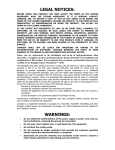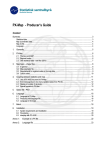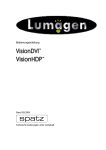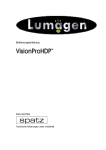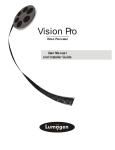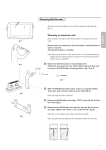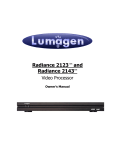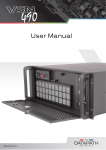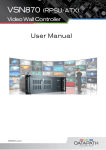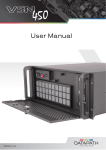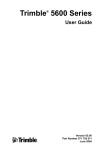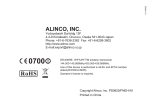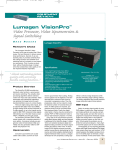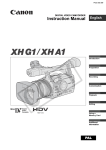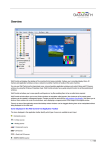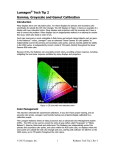Download VisionPro HDP
Transcript
LEGAL NOTICES: BEFORE USING THIS PRODUCT YOU MUST ACCEPT THE TERMS OF THE LICENSE AGREEMENT. READ THE LICENSE AGREEMENT. IF IT IS MISSING, CONTACT LUMAGEN, INC. TO OBTAIN A COPY. IF YOU DO NOT AGREE TO BE BOUND THE TERMS OF THE LICENSE AGREEMENT, RETURN THE PRODUCT TO THE POINT OF SALE IMMEDIATELY. BY DISASSEMBLING OR USING THE PRODUCT, YOU ACCEPT ALL TERMS OF THE LICENSE AGREEMENT. TO THE EXTENT NOT PROHIBITED BY LAW, IN NO EVENT SHALL LUMAGEN, ITS SUPPLIERS, OR ITS DEALERS, BE HELD LIABLE FOR INJURY TO PERSONS OR PROPERTY, ANY LOST REVENUE, LOST PROFIT, SPECIAL, INCIDENTAL, INDIRECT, CONSEQUENCIAL, OR PUNITIVE DAMAGES, IMPAIRMENT OF OR DAMAGE TO OTHER GOODS, HOWEVER CAUSED REGARDLESS OF THE THEORY OF LIABILITY, RESULTING FROM THE USE OF, OR INABILITY TO USE, THIS PRODUCT, EVEN IF LUMAGEN, ITS SUPPLIERS, OR ITS DEALERS, HAS BEEN ADVISED OF THE POSSIBILITY OF SUCH DAMAGE. LUMAGEN SHALL NOT BE LIABLE FOR OMISSIONS OR ERRORS IN ITS DOCUMENTATION OR SOFTWARE. LUMAGEN RESERVES THE RIGHT TO MAKE CHANGES TO ITS PRODUCTS AND DOCUMENTATION WITHOUT NOTICE. Unless you are experienced in the installation and set-up of high-performance video electronics, we suggest you hire a professional home-theater specialist to do installation and configuration of this product. We recommend that you choose a professional who has been certified by the Imaging Science Foundation™ (ISF). This equipment has been tested and found to comply with the limits for a class B digital device, pursuant to Part 15 of the FCC rules, Canadian ICES-003, and CISPR 22. These limits are designed to provide reasonable protection against harmful interference in a residential installation. This equipment generates, uses, and can radiate radio frequency energy and, if not installed and used in accordance with the instructions, may cause harmful interference to radio communications. However , there is no guarantee that interference will not occur in a particular installation. If this equipment does cause harmful interference to radio or television reception , which can be determined by turning the equipment off and on , the user is encouraged to try to correct the interference by one or more of the following measures: - Reorient or relocate the receiving antenna. - Increase the separation between the equipment and receiver. - Connect the equipment into an outlet on a circuit different from that which the receiver is connected. - Consult the dealer or an experienced radio/TV technician for help. Unauthorized modifications to this equipment may void Lumagen’s limited warranty and the user’s authority to operate this equipment. Lumagen is a registered trademark of Lumagen Inc.. VisionDVI, VisionHDP, and other Lumagen product names, are trademarks of Lumagen , Inc. Other trademarks are the property of their respective owners. WARNINGS: Do not defeat the safety features of the power supply or power cord, such as, but not limited to, removing the ground pin connection. Do not open, insert objects into, or spill liquid into, this equipment. Do not block the cooling vents. Do not program an output resolution that exceeds the maximum specified refresh rate of the attached television, or projector. Improperly set gray-bar intensity may accelerate screen burn-in. Consult a home-theater specialist for help setting gray-bar intensity. VisionPro HDP™ User Manual and Installer Guide Table of Contents Introduction ................................................................................................................... 1 Features ......................................................................................................................... 1 VisionPro HDP™ Video Processor ............................................................................... 2 User Guide ..................................................................................................................... 4 Remote Control ......................................................................................................... 4 User Commands ........................................................................................................ 5 Power ............................................................................................................................................. 5 Input Selection ................................................................................................................................ 5 Configuration Memory Selection ..................................................................................................... 5 Input Aspect Ratio Selection ............................................................................................................ 5 Image Zoom .................................................................................................................................... 5 On Screen Display........................................................................................................................... 6 Installer Guide ............................................................................................................... 6 Installation................................................................................................................. 6 Front Panel ................................................................................................................ 6 Rear Panel ................................................................................................................. 7 Command Format..................................................................................................... 8 Initial Setup − Step By Step ...................................................................................... 9 Initial Output/Input Setup:............................................................................................................... 9 Output Calibration:....................................................................................................................... 10 Input Calibration: ......................................................................................................................... 12 Installation Commands ........................................................................................... 14 Output Configuration .................................................................................................................... 14 Display Type ............................................................................................................................ 14 Vertical Output Resolution - Presets.......................................................................................... 15 Vertical Output Resolution - Programmable .............................................................................. 15 Vertical Output Refresh Rate .................................................................................................... 15 Horizontal Resolution for DVI Output....................................................................................... 15 Horizontal Refresh Rate for Analog Output............................................................................... 15 Exact Output Timing ................................................................................................................ 16 Output Size............................................................................................................................... 16 Output Position......................................................................................................................... 16 Screen Aspect Ratio.................................................................................................................. 16 Graybar Intensity...................................................................................................................... 17 Output Level............................................................................................................................. 17 Output Mode ............................................................................................................................ 17 Horizontal Sync Pulse Width .................................................................................................... 17 Copy Output Settings................................................................................................................ 17 Input Configuration....................................................................................................................... 18 Component/RGB Input Type Selection ..................................................................................... 18 Standard Definition Input Type Selection .................................................................................. 18 Linking an Input Memory to an Output Configuration ............................................................... 18 Black and White Levels ............................................................................................................ 19 Color and Hue .......................................................................................................................... 19 Chroma-Upsample-Error Correction ......................................................................................... 19 Color-Temperature and Gamma Calibration .............................................................................. 19 VisionPro HDP™ User Manual and Installer Guide Input Sizing.............................................................................................................................. 19 Non-linear Stretch..................................................................................................................... 20 Pass-Through mode .................................................................................................................. 21 Y/C Delay ................................................................................................................................ 21 Sharpness ................................................................................................................................. 21 Input Level ............................................................................................................................... 21 Input Name............................................................................................................................... 21 Select Deinterlacing Mode ........................................................................................................ 21 Flip Input Field......................................................................................................................... 22 Genlock.................................................................................................................................... 22 DVI input HDCP Capability Setting.......................................................................................... 22 DVI input EDID Display Information ....................................................................................... 23 DVI input Hotplug Mode .......................................................................................................... 23 Serial-Digital-Interface Video Inputs (Optional)........................................................................ 23 Copy Input Settings .................................................................................................................. 23 Miscellaneous Commands ............................................................................................................. 24 Calibrate Component/RGB inputs (3 and 4) .............................................................................. 24 On-Screen-Display Enable........................................................................................................ 24 Initial Power State .................................................................................................................... 24 Power-On On-Screen Message.................................................................................................. 24 Power-On and Power-Off RS232 Output Message..................................................................... 24 Lock the Configuration ............................................................................................................. 25 Test Patterns............................................................................................................................. 25 Menu Timeout .......................................................................................................................... 25 Front Panel LCD Function ........................................................................................................ 25 Zoom Step ................................................................................................................................ 25 Sidebar Pan .............................................................................................................................. 25 Other Commands...................................................................................................................... 26 Saving the Configuration............................................................................................................... 26 Save ......................................................................................................................................... 26 Save Undo................................................................................................................................ 26 Revert To Factory Settings........................................................................................................ 26 Restore Configuration Saved during calibration......................................................................... 26 Revert To Defaults For Current Output Resolution .................................................................... 26 Serial RS232 Command Interface .......................................................................... 27 Menu tree................................................................................................................. 28 For Optimal Picture Quality................................................................................... 30 Selecting the Output Resolution ............................................................................. 31 Multiple Output Mode ............................................................................................ 32 Troubleshooting ...................................................................................................... 34 Updating Software........................................................................................................ 35 Specifications ............................................................................................................... 36 VisionPro HDP™ User Manual and Installer Guide Introduction ® Thank you for purchasing the Lumagen VisionPro HDP™ Video Processor. It has been designed to offer great video processing quality, while providing the best available value. The two main sections of this manual are the User Guide and the Installer Guide. As their names imply, the User Guide provides instructions on day-to-day usage, and the Installer Guide provides initial setup information. It is important to read and understand this manual, and the display’s specifications, before setting up the video processor. Also, check the www.lumagen.com website for possible updates to the manual or software. To simplify references to video projectors, direct-view televisions and rear-projection televisions, they are all referred to as a “display” in this manual. Features The Lumagen VisionPro HDP™ Video Processor provides a cornerstone for the ultimate home theater experience. It is designed to adapt to your home theater needs, rather than having the designed-in limitations commonly found in today’s video processors. Some notable features are listed below. • Ten inputs (2 Composite/SVideo, 2 Composite/SVideo/SD-Component, 2 SD/HD Component/RGB, 2 DVI-D, and 2 standard-definition SDI) • All video processing features are supported for HDCP encrypted DVI-D inputs. • All video processing features are supported for HD analog YPBPR and RGB inputs. • Component/RGB analog and DVI-D input accept 720p and 1080i sources • Transcoding is supported for both digital and analog SD and HD inputs. • Per-pixel motion-adaptive video deinterlacing for SD and HD source sources • 3:2, 3:3 and 2:2 film pull-down frame-reconstruction for SD sources • 3:2, 3:3 and 2:2 film pull-down frame-reconstruction for HD sources • Four independent configuration memories for each input • Black-level, contrast, calibration per memory • Color, red-color-offset, green-color-offset calibration per memory • Hue, red-Hue-offset, green-Hue-offset calibration per memory • Y/C delay calibration with independent CB and CR delay • Detail enhancing scaler • Output resolution from 480p to 1080p, plus 1080i • Output width programmable in pixel increments • Programmable output color format (SD and HD component, plus RGB) • Programmable vertical refresh rate • Programmable screen aspect ratio • DVI-I output with HDCP encryption support • Optional BNC analog output (replaces DVI-A connection) • Backlit infrared remote control with on-screen menu system • RS232 serial interface for control and software-updates • Silent operation (no fan) © 2004-2006 Lumagen®, Inc. 1 Rev 1.1 VisionPro HDP™ User Manual and Installer Guide VisionPro HDP™ Video Processor The primary function of the VisionPro HDP is to act as a video switch, process the selected input, and output in the appropriate format and resolution. Standard definition (SD), enhanced-definition (ED), or high-definition (HD) video inputs are all supported in addition to a number of PC formats. Video inputs are converted to progressive video (if needed) and are then scaled the video output resolution. Interlaced video has been in use for more than 50 years and is still the most common video format. It displays half of the lines of picture information each sixtieth (or fiftieth) of a second. Each half of the image is called a field and displays either all the even lines, or all the odd lines. So, an entire image, called a frame, takes a thirtieth (or twenty-fifth) of a second to display on the screen. An “i” suffix on the resolution specification is used to indicate interlaced formats. In contrast, progressive video presents each frame as a whole. A “p” suffix on the resolution specification is used to indicate progressive formats. Converting interlaced video to progressive video is referred to as “deinterlacing.” The VisionPro HDP is comprised of four major functional sections: • Input selection, conversion to digital (if needed), and video decoding • Deinterlacing • Filtering and scaling • Conversion to analog video, or output as digital DVI-D video. These functional blocks are shown below. DVI-D 1 Deinterlace DVI-D 2 Filtering and Scaling YPBPR/RGB 3 YPBPR/RGB 4 SVideo/Vid 5 SVideo/Vid 6 YPbPr/SVid/Vid 7 Input Select, A-to-D, and TV Decoder YPbPr/SVid/Vid 8 DVI-D with HDCP DVI-D Digital-toAnalog Conversion RGB/ YPBPR SDI 9 SDI 0 VisionPro HDP Functional Block Diagram © 2004-2006 Lumagen®, Inc. 2 Rev 1.1 VisionPro HDP™ User Manual and Installer Guide Composite and SVideo inputs automatically select between NTSC, PAL and SECAM formats. Component/RGB and DVI-D inputs accept SD, ED and/or HD video at either 50 or 59.94 Hertz. HDCP encryption is supported for DVI-D inputs. If encrypted, DVI-D inputs are decrypted, processed, scaled and then re-encrypted for output as DVI-D (i.e not just a “pass-through” function). Note: HDCP encrypted DVI-D sources must be re-encrypted for output. So, the analog output is disabled in this case. Also the display must be HDCP capable to show these encrypted sources. If the video input is interlaced, it is first deinterlaced into a progressive format. Proprietary scaling algorithms are used to scale the resulting progressive video to the optimal size for the display. The Lumagen video processor is programmable in scanline increments. For analog outputs, video is over-sampled to provide the best possible image quality. For DVI-D outputs the resolution is programmable in both scanline increments vertically, and pixel increments horizontally. As part of the scaling process, digital filtering is used to enhance the image detail. This enhancement allows standard definition inputs, such as DVDs, to appear to be much higher resolution, even when viewed on the large screen sizes common in home theaters. When the digital processing is completed, video is converted to analog using digital-toanalog converters (DACs), or is output as DVI-D (digital) video. To accommodate the various video displays, the output type is programmable. It can be set to analog YPRPB, RGBHV, RGBS or RGsB, with programmable sync type and polarities. YPRPB can be selected with either the SD or HD color formats. DVI-D video can use either the “PC” range (full range black to white), or “video range” (reduced range for black to white to allow for blacker-than-black and whiter-than-white levels). An infrared remote control is provided. Alternately, the serial RS232 port can be used for control, or for software update. Critical display setup parameters have direct commands. Other functions use an on-screen menu. Every input has four independent configuration memories, to allow options such as day/night specific modes for both NTSC and PAL sources. In addition, HD capable inputs have four input-resolution-based sub-memories. These allow independent calibration and setup for 480i/p or 576i/p sources, 720p sources, 1080i sources, plus an additional sub-memory for another resolution. This feature is very useful for satellite receivers, and other source devices such as D-VHS HD video recorders, that can output the native resolution of the source material. For example, in this “hybrid mode,” SD sources are output as either 480i/576i or 480p/576p, 720p source material is output as 720p, and 1080i material is output as 1080i. Each of these source formats can be independently calibrated for each of the four input memories. © 2004-2006 Lumagen®, Inc. 3 Rev 1.1 VisionPro HDP™ User Manual and Installer Guide User Guide This section describes the user interface for everyday functions. For initial setup information see the Installer Guide section (page 6). User commands can be entered with the supplied infrared remote control, or using the RS232 serial control port. Contact the installer for information on user commands if the RS232 serial port is used. Remote Control The infrared remote control is shown below. Input Aspect Ratio Selection Power Input Aspect Ratio Selection Step Input Aspect Ratio Selection Step Command completion and OSD Image Zoom Exit/Cancel Activate Menu Numeric Entry and Input Selection Configuration Memory Selection © 2004-2006 Lumagen®, Inc. 4 Rev 1.1 VisionPro HDP™ User Manual and Installer Guide User Commands Power Turn power on by pressing ON. Place the VisionPro HDP in standby-mode by pressing STBY. Input Selection The ten inputs are numbered from 1, … 9, 0. To select an input, press the respective button (1 to 0). NOTE: To select an input, the menu must not be active. Configuration Memory Selection There are four configuration memories for each input. These are referred to as memory “A,” “B,” “C,” and “D.” The first two are selected by pressing MEMA, and MEMB, respectively. To select memory C, press MENU then MEMA. To select memory D, press MENU then MEMB. Note, RS232 codes are provided to directly access MEMC and MEMD. When NTSC/PAL auto-selection is enabled (i.e. output mode set to AUTOIND), MEMA and MEMC are linked and used for NTSC and PAL, respectively. In this mode, if MEMA or MEMC is active, an NTSC source automatically selects MEMA and a PAL source automatically selects MEMC. MEMB and MEMD are also linked, with MEMB used for NTSC and MEMD for PAL. Each configuration memory is independent of all others. To allow these memories to be used for mode selection (e.g. day/night), the type remains unchanged when a new input is selected. (e.g. if input 2 memory B is active pressing 3 selects input 3 memory B). Input Aspect Ratio Selection The four source aspect ratios are: 4:3, letterbox, 16:9, and 1.85. They can be selected by pressing the 4:3, LBOX, 16:9, or 1.85 buttons, respectively. Use 4:3 for standard fullscreen material. Use LBOX for “letterbox” material, such as analog-television movies shown with black bars above and below the image. For material labeled as “Enhanced for 16:9 televisions” selecting 16:9 is generally best. However, 1.85 can be used for sources “Enhanced for 16:9 televisions” that have a 1.85 aspect ratio stretched vertically to 16:9. The 4:3 input aspect ratio mode can also be programmed as a “non-linear stretch” mode so 4:3 sources fill a 16:9 screen. See the Nonlinear Stretch section (page 20) for details. Note: Make sure the “television aspect ratio” setting is 16:9 in the setup menu of all source devices that support this feature (e.g. DVD players), even if the screen is not 16:9. Image Zoom After the input aspect ratio has been selected, the image can be zoomed in to better fit the screen. The zoom function uses the ‡ and ˆ arrow buttons. When the menu is off, the ‡ arrow button zooms in and the ˆ arrow button zooms out. © 2004-2006 Lumagen®, Inc. 5 Rev 1.1 VisionPro HDP™ User Manual and Installer Guide On Screen Display Pressing OK successively, when the menu is off, displays input and output status. Installer Guide Installation Unpack the shipping container. Save the container and packing materials incase they are needed later. Place the VisionPro HDP Video Processor on a component shelf and connect as described in the Rear Panel section. The cooling vents must be clear of obstructions to provide for convection cooling. Install two AAA batteries in the remote control. The following items should be included: VisionPro HDP Video Processor Infrared remote control External power supply User manual License agreement Warranty card Rack-mount ears. Front Panel NOTE: The front panel display does NOT stay on by default. To change the LCD function to stay illuminated to indicate “power-on,” see the “Front Panel LCD Function” section (page 25). The front panel has an LCD display, which will light to show command activity (default), or LCD light can be left on while power is on as a “power-on” indicator (user selectable). When the LCD light is set to “activity” it illuminates for a short time after commands are received. When the LCD light is set to “power” it stays illuminated as long as the VisionPro HDP is on, turning off briefly when a command is received. The front panel is shown below. VisionPro HDP HD Video Processor © 2004-2006 Lumagen®, Inc. POWER INPUT ASPECT IR sensor Aspect Ratio Input Select Power 6 Rev 1.1 LCD display with backlight VisionPro HDP™ User Manual and Installer Guide Rear Panel All connections are made on the rear panel, which is shown below. OUTPUT HCSYNC Y POWER RS-232 CONTROL No user serviceable parts inside. Refer servicing to factory authorized agent. 5V DC G/ Y R/ P R INPUT 6 - SD ONLY INPUT 4 - SD/ ED/ HD VSYNC B/ PB OUTPUT OUTPUT INPUT 1 INPUT 2 DVI-D DVI-D DVI-D Y This device complies with part 15 of the FCC Rules, Canadian ICES-003, and CISPR 22. Operation is subject to the following two conditions: (1) This device may not cause harmful interference, and (2) this device must accept any interference received, including interference that may cause undesired operation. PR PB PR PB INPUT 3 - SD/ ED/ HD INPUT 8 - SD ONLY Y C Y Y C Y INPUT 5 - SD ONLY INPUT 0 C/ PR PB C/ P R PB INPUT 7 - SD ONLY SDI SDI INPUT 9 Manufactured in U.S.A. The user must read and accept license agreement before using this product. The connections are: • RS-232: Connect the supplied external 5 Volt DC, at 5 amp, power supply. • POWER: Connect to the external supplied 5 Volt DC power supply. • Analog Video output: Provides analog RGB or component video output. • DVI-I Video output: Provides digital (DVI-D) video output. • INPUT 1 to INPUT 0: Standard input connections. Input 1 and 2: DVI-D with HDCP support Input 3 and 4: SD/HD Component, or RGB Input 5 and 6: SVideo or Composite (selectable) Input 7 and 8: SD Component, SVideo or Composite (selectable) Input 9 and 0: SDI (Serial-Digital-Interface) The RS232 serial port allows the use of an external home theater RS232 controller. This is the same as a PC DB9 serial port, except no “flow-control” is used. For updates, connect to the PC using a DB9-F to DB9-F null-modem cable. Analog output supports RGBHV, RGsB, RGBS or component, using BNC connectors. For component output the Y channel is connected to green, the PR channel to red and the PB channel to blue. Digital output uses a DVI-D connection, which can also drive a HDMI display using an adaptor cable. It is possible to connect two RGsB (sync-on-green), two RGBS (TTL level sync), or two RGBcvS (video level sync) video sources, or a combination, using one or both of the component/RGB inputs For RGsB, the input is specified as RGsB in the input TYPE menu as (MENU → IN → TYPE → RGsB). The separate composite sync types are specified as RGBS (MENU → IN → TYPE → RGBS) or for RGBcvS as SCART (MENU → IN → TYPE → SCART). For all RGB formats, the Y channel is used as Green, the PB channel as Blue and the PR channel as Red. For the separate composite sync types, input 5 is used for sync input for input 3, and input 6 is used for sync input for input 4. Up to two RGBHV (TTL level sync) inputs can be specified (MENU→IN→TYPE→RGBHV) using component input 3 and input 5 together or using component input 4 and input 6 together. In this case, composite or horizontal sync uses the Y connection of input 5, or 6, and the vertical sync when needed uses the C connection of input 5, or 6. © 2004-2006 Lumagen®, Inc. 7 Rev 1.1 VisionPro HDP™ User Manual and Installer Guide Command Format Commands are selected with the supplied infrared remote, or the RS232 serial port. To prevent possible command conflict, only one of these should be used at a time. The infrared remote control command notation is described below: • Remote buttons are named as shown on the remote in a bold font. Example: MENU. • For comma separated lists, press the buttons in the sequence shown. • For parenthesized lists, select one button from the list. • For square-bracketed lists, press as needed. Example: For the list […, †, ‡, ˆ], press the arrow keys as needed. • For menu commands press the MENU button. The ‡, and ˆ arrow keys are used to select the function. The † arrow key (or OK) is used to enter sub-menus. This is shown as: MENU → MenuItem → MenuItem. The … arrow key (or EXIT) steps up one menu level. • Numerical entries are listed as value. While entering the value, the … arrow key acts as a backspace key. • Some commands are activated immediately. Other commands must be explicitly accepted by pressing OK. If needed, OK is listed as part of the command. • Pressing EXIT cancels a partially completed command. If the menu system is active, EXIT returns to one level higher in the menu system. • There are four independent configuration memory types for each input (MEMA, MEMB, MEMC and MEMD). The input setup and output resolution/timing can be set independently for each memory. Note that, initially, there is a single output mode for all configuration memories. To program an input memory, first select the input, then select the desired configuration memory and use the menu system to configure. • Some menu commands are only available when their respective input is selected. • Before changes are saved, they can be discarded by entering standby mode. • To prevent unintended configuration changes, before saving, use the lock command. • Save the configuration after making changes, or changes will be lost when entering STBY mode. If the serial port is used, the ASCII character associated with the respective remote control button must be sent. See the Serial RS2323 Command Interface section (page 27) for information on serial commands. © 2004-2006 Lumagen®, Inc. 8 Rev 1.1 VisionPro HDP™ User Manual and Installer Guide Initial Setup − Step By Step The setup sequence for typical configurations is shown below. See the Command Format section (page 8) for information on entering commands. Typically, not all commands shown here are needed. Only the most common setup commands and options are shown in this section. See the Installation Commands section (page 14) for additional commands and options. Initial Output/Input Setup: • Connect video cables as described in the Rear Panel section. Then connect power and turn all required components on. • Select the output type: Skip this step if a DVI-D/HDMI display is connected. If a DVID display is connected, DVI-D will be selected by default, otherwise analog RGBHV output is the default. For analog output, the mode can be changed as shown below. For more info see the Output Configuration Section (page 14). HD YPRPB trilevel: MENU 0 1 1 OK HD component with embedded trilevel sync SD YPRPB bilevel: MENU 0 1 5 OK SD component with embedded bilevel sync • Set vertical refresh rate: Skip this step if the output rate is to be 59.94 (U.S.A and some other countries). The default vertical refresh rate is 59.94, but it can be changed to be from 23.98 up to 120 Hertz. The maximum rate varies depending on resolution. MENU 0 4 value OK Value is in hundredths (e.g. 59.94 is 5 9 9 4) • Set output resolution: The output resolution defaults to 480p, which 480 active scanlines progressive format. A different output resolution can be selected using the menu or by direct command. The menu command is: MENU → OUT → RES → VRES → value OK The direct commands to select output resolution are: 480p: MENU 0 2 1 540p: MENU 0 2 2 600p: MENU 0 2 3 720p: MENU 0 2 4 768p: MENU 0 2 5 840p: MENU 0 2 6 1080p: MENU 0 2 7 1080i: MENU 0 2 8 Other: MENU 0 3 value [ˆ,‡] OK, where ˆ is interlaced and ‡ is progressive (default). • For digital displays using the DVI-D output (skip this step for analog output), it is important to operate then at their native resolution, so as to achieve a “pixel-perfect” image. This maximizes Lumagen’s video processing advantages by disabling the display’s internal processing. Some displays do not support their native resolution as an input, or do not operate in “pixel-perfect” mode even when they are driven at their native resolution. Consult with the display’s manufacturer for more information on if the display can achieve a pixel-perfect image. • Set the horizontal resolution. Skip this step for analog output, or if the default HRES selected by the Lumagen for user selected VRES is correct. The command is: MENU → OUT → RES → HRES → value OK © 2004-2006 Lumagen®, Inc. 9 Rev 1.1 VisionPro HDP™ User Manual and Installer Guide • Some DVI-D/HDMI displays can achieve a “pixel-perfect” image, but require specific pixel timings for all parameters, not just active pixel counts. Note: Skip this step for analog output. Lumagen video processors can accommodate these displays using the TIMING command. For more information on using this command see the Exact Output Timing section (page 16). The command is: MENU → OUT → RES → TIMIING • If pixel perfect mode cannot be achieved, adjust overscan. Skip this step for analog output. If pixel-perfect mode has been achieved, skip this step, since these operations may disable pixel-perfect mode. Adjust size and position to have approximately 0% to 1% overscan, as shown using the Lumagen overscan test pattern. Note that overscan will be adjusted to approximately 2% while adjusting the input configuration. Select the overscan test pattern with MENU → MISC → TPAT → OK. Then use the right arrow to step to the overscan pattern. If the display has output size and position, use them. Otherwise use the Lumagen commands. Note that the Lumagen’s commands cannot be entered while the Lumagen overscan pattern is displayed, so this method may require some iteration. The commands are: Output size: MENU → OUT → RES → SIZE → […,†,ˆ,‡] OK Output position: MENU → OUT → RES → POS → […,†,ˆ,‡] OK • Set the output aspect ratio to match the screen. Skip this step if the screen aspect ratio is 16:9 (the default). Press “MENU 0 6 value OK” where “value” is the screen aspect ratio in hundredths (4:3 is MENU 0 6 1 3 3 OK) • Set the output level. For DVI-D/HDMI displays it is important to match the display’s requirement for this parameter. If unsure, selecting DVI-D as VIDEO output level is safer. Most analog displays work well with either pedestal setting. The commands are: For analog: MENU → OUT → LEVL → PDSTL → (0 IRE, 7.5 IRE) OK For DVI-D: MENU → OUT → LEVL → DVILVL → (VIDEO, PC) OK • Select the input type for the component/RGB inputs 3 and 4. Skip this step if input 3 and 4 are component and use the correct color-space. Select desired input, then press MENU → IN → TYPE → (SDYPBPR, HDYPBPR, RGBHV, RGBS, RGsB), OK • Select the input type for the standard definition analog inputs 5 to 8. Skip this step if the default modes for these inputs are correct. Note inputs 5 and 5 can only support SVideo or composite (VID). Select desired input, then press MENU → IN → TYPE → (VID, SVID, YPBPR), OK • Set the video input levels. If unsure, selecting 0 IRE for analog, and PC input levels for DVI-D, is safer. The commands are: For analog inputs: MENU → IN → CONFIG → ADJ → LEVL → (0 IRE, 7.5 IRE) OK For DVI-D inputs: MENU → IN → CONFIG → ADJ → LEVL → (VIDEO, PC) OK Output Calibration: • The interface between the Lumagen and display should be calibrated first. This is best accomplished using the internal Lumagen test patterns to assure that any variance in a © 2004-2006 Lumagen®, Inc. 10 Rev 1.1 VisionPro HDP™ User Manual and Installer Guide • • • • source (either size or levels) does not affect the calibration. Later, differences between inputs can be calibrated using the source devices. If grayscale is to be calibrated, a base line calibration should also be done after setting black and white levels. To calibrate the black and white levels, select the Lumagen contrast test pattern (MENU → MISC → TPAT → OK), then use the left-arrow key to select the contrast test pattern. This pattern has two white rectangles and two black rectangles. In the dark areas, there are two vertical bars – One at 4 IRE and one at –4 IRE. The white area has two vertical bars – one at 96 IRE and one at 104 IRE. Note that 0 IRE is reference black and 100 IRE is reference white. Since –4 and 104 are outside the nominal black to white range, not all displays will show these levels. First adjust the display’s black level using the brightness control. Adjust so that the 4 IRE bar is barely visible against the black background (0 IRE). There should be no visible difference between the black background areas and the –4 IRE bar. This is a secondary indication verses the 4 IRE bar, but can be useful in optimizing the black level in displays that support blacker-than-black. Next adjust the white level using the display’s contrast control. Adjust so that the 96 IRE bar is barely visible against the white (100 IRE) background. If a display supports whiter-than-white, the 104 IRE bars may be visible. This is not a requirement, but does show that there is some additional headroom above white. If either or both the 4 IRE and/or 96 IRE bars cannot be seen after adjusting the controls, recheck that the appropriate output level has been selected. Grayscale, and gamma, should be calibrated at this point. Calibrating these parameters is an essential part of the video calibration process. However, a trained technician using the appropriate equipment must calibrate grayscale and gamma. Grayscale calibration adjusts the “color of gray” so that the color “gray” adheres to the industry standard D6500 point, at all levels from black to white. Most HDTVs, and projectors, are intentionally miss-calibrated to maximize their brightness for the showroom. This calibration step is necessary to correct this error, so the image appears as the producers intended. Gamma is the response curve between black and white and also has an industry defined standard that should be followed. Lumagen has developed a unique 11-point parametric grayscale/gamma calibration feature, which allows both grayscale and gamma to be optimized over the entire range from black to white, and not just at one or two points. Lumagen strongly suggests that a qualified video technician be hired to do grayscale and gamma calibration. A technician with the proper training and equipment must do the grayscale/gamma calibration. Contact Lumagen for the service codes necessary to use the grayscale and gamma calibration features. After completing the output calibration, copy the results to all configuration memories using the following command: MENU → IN → COPY → ALL → OK It is a good idea to save the configuration before proceeding. Use the SAVE command as shown below: MENU → SAVE → SAVE → OK © 2004-2006 Lumagen®, Inc. 11 Rev 1.1 VisionPro HDP™ User Manual and Installer Guide Input Calibration: • Each input source should be calibrated, starting with the DVD. The Lumagen provides four independent input configuration memories for each input. So, calibration for each input is independent of other inputs and multiple independent calibrations can be done for each input. One use for the multiple calibrations for each input is to calibrate MEMA for day and MEMB for night viewing. Typically the DVD input is calibrated first using a DVD calibration disc. Then the results of the DVD calibration are then copied to all input memories as a reference starting point for the other sources. • Play a DVD calibration disc and select it as the input source. AVIA™ test patterns are referenced here, but Digital Video Essentials™ is also excellent. • Select Lumagen input aspect ratio as 16:9 for a 16:9 screen, or 4:3 for a 4:3 screen. This is necessary to properly set the overscan. • Select Advanced AVIA → Video Test Patterns → Special Tests → Overscan. • Adjust the input size and position. This selects which pixels are captured. The corner being adjusted is moved toward the center to make it easy to calibrate. If the corner being adjusted cannot be seen on-screen, go back to the Initial Output/Input Setup section and correct the output size, then come back to this step. Adjust the top-left of the image first. Then adjust the bottom-right. Input top-left: MENU → IN → CONFIG → ADJ → SIZE → TOPL → […,†,ˆ,‡] OK Input bottom-right: MENU → IN → CONFIG → ADJ → SIZE → BTMR → […,†,ˆ,‡] OK • Select Advanced AVIA → Video Test Patterns → Gray Scale & Levels → Black and White Levels → Needle Pulses. • Set the black level. Follow AVIA instructions for setting the black level. Since the Lumagen-to-display levels were set above in the Output Calibration section, the Lumagen internal Black level control should be used. It is recommended that the black frame with two moving bars (2 and 4 IRE) be used for setting black level. The reason is that the black level varies with the average intensity on the screen for a lot of displays and the black level is most critical in dark scenes. The command is: MENU → IN → CONFIG → COLR → BLCK → [‡,ˆ] OK • Set the white level. Follow AVIA instructions for setting the white level (often called contrast). Since the Lumagen-to-display levels were set above in the Output Calibration section, the Lumagen internal Contrast control should be used. The command is: MENU → IN → CONFIG → COLR → CONT → [‡,ˆ] OK • Select Advanced AVIA → Video Test Patterns → Color → Standard Colorbars. • Set Color and Hue and then the Color and Hue offsets for red and green. Set the display’s Color and Hue to default before performing this calibration step. Follow instructions on the AVIA disc for the color bar images. First set Color and Hue using the AVIA blue colorbar pattern and the blue filter. Next set the red color (COLRED) and Hue (HUERED) offsets using the red colorbar pattern and the red filter. Finally set © 2004-2006 Lumagen®, Inc. 12 Rev 1.1 VisionPro HDP™ User Manual and Installer Guide the green color (COLGRN) and Hue (HUEGRN) offsets using the green colorbar pattern and the green filter. MENU → IN → CONFIG → COLR → COLR → (COLR, HUE, COLRED, HUERED, COLGRN, HUEGRN) → […, †, ˆ, ‡] OK • Select Advanced AVIA → Video Test Patterns → Special Tests → Y/C-Delay. • Set Y/C Delay. Use the Lumagen Control to minimize the error in the blue and red timing verses Luma. On the right part of the screen there are red bars on a yellow background. Adjust to balance any color transition errors on the left and right edges of the red bars. The CB and CR channels are calibrated independently. MENU → IN → CONFIG → ADJ → YC-DLY → (CBCR, CB, CR) → [… , † , ˆ, ‡] OK • Copy the DVD configuration to all configuration memories (MENU → IN → COPY → OK). • If desired, change to MEMB and calibrate for a different amount of room light. Then switch back to MEMA, and again copy the DVD configuration to all configuration memories. • Calibrate the other inputs. • Name the inputs, if desired (MENU → CONFIG → IN → NAME → OK and follow directions). • Set power-on message, if desired (MENU → MISC → POWR → MSG → […, †, ˆ, ‡] OK) • Lock the configuration, if desired (MENU → MISC → LOCK → LOCKED OK) • SAVE THE CONFIGURATION (MENU → SAVE → SAVE OK) © 2004-2006 Lumagen®, Inc. 13 Rev 1.1 VisionPro HDP™ User Manual and Installer Guide Installation Commands See the Command Format section (page 8) for a description of the installation command interface. Output Configuration The factory-default is 480p at 59.94 Hertz, with a 1.78 (16:9) aspect ratio. For analog output, the default mode is RGBH-V-. See the Selecting the Output Resolution section (page 31) for more information on which output resolution to use. If more than a single output resolution is required, see the Multiple Output Mode section (page 32). Note: If the analog output is enabled, it is turned off for HDCP encrypted sources. Display Type By default (Auto), if a DVI-D display is detected, DVI-D output is enabled, and analog output is disabled. If no DVI-D display is detected, analog RGBHV output is enabled, and DVI-D is disabled. The output can also be manually selected. If both are enabled, the analog output must be one of the RGB types. The commands are: Auto: MENU 0 9 3 2 1 Output DVI-D only, if detected, else analog only DVI-D only: MENU 0 9 3 2 2 DVI-D only, even if DVI-D is not detected Analog only: MENU 0 9 3 2 3 Analog only, even if DVI-D is detected Both: MENU 0 9 3 2 4 Output DVI-D and analog RGB The following commands select the output color-space and synchronization type for the analog output. The selection takes effect immediately. The arrow buttons are then active and have immediate effect. If no arrow buttons are pressed the default mode is used. Press the OK button when done to prevent the arrow buttons from continuing to change the sync type. RGBHV: MENU 0 1 2 [ˆ,‡] […, †] OK ˆ sets both H and V sync as negative (default) ‡ sets both H and V sync as positive. … sets negative H sync. If needed, select after the ˆ or ‡ button. † sets positive H sync. If needed, select after the ˆ or ‡ button. RGBS: MENU 0 1 3 [ˆ,‡] OK ˆ sets negative composite sync (default) ‡ sets positive composite sync RGsB: MENU 0 1 4 [ˆ,‡] OK ˆ sets embedded bilevel sync ‡ sets embedded trilevel sync (default) HD color-space YPRPB: MENU 0 1 1 [ˆ,‡] OK ˆ sets embedded bilevel sync ‡ sets embedded trilevel sync (default) SD color-space YPRPB: MENU 0 1 5 [ˆ,‡] OK ˆ sets embedded bilevel sync (default) ‡ sets embedded trilevel sync © 2004-2006 Lumagen®, Inc. 14 Rev 1.1 VisionPro HDP™ User Manual and Installer Guide Vertical Output Resolution - Presets Select one of the preset output vertical resolutions. The only interlaced format supported is 1080i. The command format for each resolution is: 480p: MENU 0 2 1 OK 540p: MENU 0 2 2 OK 600p: MENU 0 2 3 OK 720p: MENU 0 2 4 OK 768p: MENU 0 2 5 OK 840p: MENU 0 2 6 OK 1080p: MENU 0 2 7 OK 1080i: MENU 0 2 8 OK Vertical Output Resolution - Programmable Manually set the output vertical resolution from 480p to 1080p, in scanline increments. To select between 1080p, 1080i, and 1080sF24, select 1080 lines and then use arrow buttons to selected correct format. 1080p output also allows the choice between two modes. MODEA follows the SMPTE standard. MODE B is required for some 1080p devices, such as the JVC™ HD2K™ projector. Out of range values are ignored. The command format is: MENU 0 3 value OK or MENU → OUT → RES → VRES → value, [ˆ,‡] OK Vertical Output Refresh Rate Set the vertical refresh rate. The range is 23.98 (DVI-D), to 120 Hertz in hundredths (e.g. 75.00 is entered as 7 5 0 0). The maximum refresh rate depends on the output resolution. For DVI-D Segmented-Frame (sF) output format, select 1080 lines and then select 24sF (or 25 sF). Out-of-range values are ignored. The command format is: MENU 0 4 value OK or MENU → OUT → RES → VRATE → value OK Horizontal Resolution for DVI Output For DVI-D output, use this command to set the active horizontal resolution if the HRES selected by the Lumagen does not match the display. The command format is: MENU 0 7 value OK or MENU → OUT → RES → HRES → value OK Horizontal Refresh Rate for Analog Output Note: Generally this command should not be used. Set the analog output horizontal refresh rate in Hertz. The vertical total scanline count is adjusted to achieve the specified horizontal frequency, if possible. The active vertical resolution is not changed. Out-of-range values are ignored. The command format is: MENU 0 5 value OK or MENU → OUT → RES → HRATE → value OK © 2004-2006 Lumagen®, Inc. 15 Rev 1.1 VisionPro HDP™ User Manual and Installer Guide Exact Output Timing The Timing command sets output timing in pixel increments. This command can be selected using the menu or with a direct command. The menu command screen is: MENU → OUT → RES → TIMING To directly select press: MENU 0 9 4 3. An example screen for 480p is shown below: 0 1 2 3 VTOT VRES VSYN VFRN 8 VRATE 525 480 5 5 4 5 6 7 59.94 HTOT HRES HSYN HFRN 858 720 54 15 9 EXECUTE To program the pixel timing, first enter the single-digit (0-8) for a parameter to change. This will bring up a sub-menu where the desired value can be entered. Select the value and press OK. Continue setting all parameters that need to be changed and then accept all the changes by executing the command. That is, changes do not take effect until option 9 (EXECUTE) is selected. This updates the hardware timing, and gives the user 15 seconds to accept the changes. If the accept-screen times out, or if the user presses EXIT while it is active, the output timing reverts to the old timing and the Timing command screen is once again displayed without the changes made. The parameters entered are for vertical (V) or horizontal (H), for the total pixel count (TOT), the active pixel count (RES), the sync-pulse duration (SYN), or the front porch (FRN). Note the front-porch is the time after active video and before the sync pulse. The back-porch timing is automatically calculated. The vertical rate (VRATE) can also be set. Output Size Change scale of the image with respect to the active output. The command format is: MENU → OUT → RES → SIZE → [… , † , ˆ, ‡] OK or MENU 0 9 4 1 [… , † , ˆ, ‡] OK Output Position Position the image with respect to the active output. The command format is: MENU → OUT → RES → POS → [… , † , ˆ, ‡] OK or MENU 0 9 4 2 [… , † , ˆ, ‡] OK Screen Aspect Ratio. Select the screen aspect ratio. The screen aspect ratio range is 1.33 (4:3) to 2.35 and is entered in units of hundredths (e.g. 16:9 is entered as 1 7 8). The command format is: MENU 0 6 value OK or MENU → OUT → ASPECT → value OK © 2004-2006 Lumagen®, Inc. 16 Rev 1.1 VisionPro HDP™ User Manual and Installer Guide Graybar Intensity Note: Consult a home theater specialist for assistance setting the graybar intensity. Some degree of burn-in will occur on any susceptible display, but this command can help minimize it by allowing the intensity of graybars to be adjusted. The command format is: MENU → OUT → GBAR → SIDE → [ˆ, ‡] OK Output Level For analog output, specify black pedestal as 0 IRE or 7.5 IRE. Typically this is set to 0 IRE for fixed-pixel displays, and 7.5 IRE for CRT displays. For DVI-D output, set levels as video (allows blacker-than-black and whiter-than-white) or PC (full-range black to white). If unsure, use 7.5 IRE for analog and PC levels for DVI-D. The commands are: For analog: MENU → OUT → LEVL → PDSTL → (0 IRE, 7.5 IRE) OK For DVI-D: MENU → OUT → LEVL → DVILVL → (VIDEO, PC) OK Output Mode When set to factory-defaults, there is a single output configuration for all input memories. If the output mode is set to one of the two independent modes (INDEP, or AUTOIND), each input memory can select one, for SD inputs, or four (one for each input resolution) for HD capable resolutions, of the eight (0 to 7) independent output configurations. The command to set the output mode is: MENU → OUT → MODE → (SAME, INDEP, AUTOIND) OK NOTE: After changing to an independent output mode, all memories use output mode 0. To change an output configuration, the appropriate input and input memory must be selected, then, the output configuration number must be selected using the input menu’s OUTSEL command. Changes to the output timing will affect the selected output configuration. When NTSC/PAL auto-selection is enabled (AUTOIND), MEMA and MEMC are linked and automatically selected for NTSC and PAL, respectively. That is, if MEMA or MEMC is active, an NTSC source automatically selects MEMA and a PAL source automatically selects MEMC. MEMB (NTSC) and MEMD (PAL) are linked in the same way. Horizontal Sync Pulse Width Note: Generally this command should not be used. Some displays require a narrower horizontal sync pulse than standard SMPTE timing. This command allows the HSync pulse width to be controlled. The command format is: MENU 0 9 4 0 → [… , † ] OK Copy Output Settings Note: This command is only visible if an independent output mode is selected. For independent modes (INDEP, or AUTOIND), this command copies the current output configuration to the selected configuration, or configurations. The command format is: MENU → OUT → COPY→ (ALL, 0 – 7) OK © 2004-2006 Lumagen®, Inc. 17 Rev 1.1 VisionPro HDP™ User Manual and Installer Guide Input Configuration After the output is configured and calibrated, calibrate the DVD input, and then copy that configuration to all the other configuration memories (see the Copy Input Settings section on page 23). Then calibrate the other inputs. To program an input memory, select the input, then select the configuration memory and use the menu system to configure. Each of the four input configuration memories is independent. So, for example, if memory A for an input is to be the same as memory B for that same input, the input configuration must be copied from one to the other. Component/RGB Input Type Selection The source type must be programmed for the component/RGB inputs (3 and 4). Select the input then program its type. For component input mode, either the standard-definition (SD) or high-definition (HD) color-space may be selected. The command format is: MENU → IN → TYPE → (SDYPBPR, HDYPBPR, RGBHV, RGBS, RGsB) OK The analog-to-digital converter for these inputs is calibrated at the factory. However, since source levels vary these inputs should be calibrated with the intended source device to achieve optimal performance. This is possible if the source is capable of displaying a 100 IRE Window Pattern. Use the “Calibrate Component/RGB Input” command. Standard Definition Input Type Selection The source type must be programmed for the standard definition inputs (5 to 8). Inputs 5 and 6 can be composite, or SVideo. Inputs 7 and 8 can be composite, SVideo, or Component. The command format is: MENU → IN → TYPE → (VID, SVID, YPRPB) OK Linking an Input Memory to an Output Configuration NOTE: See the Multiple Output Mode section (page 32) for information on using output configurations. If the output mode is set to independent (INDEP or AUTOIND), each SD input memory uses one of eight independent output configurations. For HD capable inputs, each memory has four resolution “sub-memories” (PC, 480i/480p (or 576i/576p), 720p, 1080i). The PC memory is used for any single input resolution other than those listed above. For these HD inputs, when Multiple-Output-Mode is enabled, the output-configuration numbers for each of these is listed as four numbers separated by a “/” in the order shown above. The output-configuration number for each sub-memory must be set independently, but all submemory selections can be set independent of which input submemory is active. First select the desired input memory. Then use this command to select the desired output configuration. The command is: MENU → IN → OUTSEL → (0 – 7) OK © 2004-2006 Lumagen®, Inc. 18 Rev 1.1 VisionPro HDP™ User Manual and Installer Guide Black and White Levels To set the black-level (also referred to as brightness) and white-level (also referred to as contrast) using the Lumagen controls, select the needle pattern in AVIA (Advanced AVIA → Video Test Patterns → Gray Scale & Levels → Black and White Levels → Needle Pulses) and follow the instructions on the AVIA disk. The command format is: MENU → IN → CONFIG → COLR → (BLCK, CONT) → [‡,ˆ] OK Color and Hue Note: Set the display’s Color and Hue to their default values. Use the Advanced AVIA color test pattern to set Color and Hue (Advanced AVIA → Video Test Patterns → Color). Follow instructions on the AVIA disc. Calibrate using the blue color bars and blue filter (COLR and HUE). Then calibrate using the red color bar image and red filter (COLRED for HUERED), and then the green color bar image and green filter (COLGRN and HUEGRN). If an RGB (analog or DVI) output mode is used to drive the display, and if the display uses RGB color-space through its entire datapath, enter the Lumagen service mode. This will disable the two primaries not being adjusted, which eliminates the need to use the color filters for this adjustment. If it is uncertain whether the display has an all RGB datapath, leave the Lumagen in user-mode and use the filters. MENU → IN → CONFIG → COLR → COLR → (COLR, HUE, COLRED, HUERED, COLGRN, HUEGRN) → […, †, ˆ, ‡] OK Chroma-Upsample-Error Correction Some digital video sources, such as some DVD players, have an error in design that affects the Chroma video quality. The CUE filter can be enabled to mitigate this error. For high quality sources that do not have the CUE artifact, disabling the CUE filter may increase Chroma resolution. The CUE filter is on by default. The command format is: MENU → IN → CONFIG → COLR → CUE → (ON, OFF) OK Color-Temperature and Gamma Calibration Lumagen video processors can correct the color-of-gray (also called grayscale, colortemperature or white-balance) and gamma using their internal 2, 5, or 11 point parametric grayscale calibration function. This adjustment requires the appropriate test equipment and training, so has been put in the service menu. Contact Lumagen for details. Input Sizing Input sizing can be used to compensate for source active image size differences. Note, the input size command does not affect the output size or position. Rather, it affects which input pixels are captured for processing. Use the TOPL command to select the top left most active input pixel. Use the BTMR command to select the bottom right most active pixel. For these commands, the active corner is temporarily moved toward the center of the screen. Select the scanline using the ‡ and ˆ arrows, and the pixel using the … and † arrows. The command format is: MENU → IN → CONFIG → ADJ → SIZE → (TOPL, BTMR) → [… , † , ˆ, ‡] OK © 2004-2006 Lumagen®, Inc. 19 Rev 1.1 VisionPro HDP™ User Manual and Installer Guide Non-linear Stretch Non-linear-stretch (NLS) is used to horizontally stretch a 4:3 aspect ratio source to fit a display that has a wider aspect, such as 16:9. The image is stretched by a constant amount in the center and by an increasing amount approaching the left and right edges. This eliminates the black sidebars normally seen when viewing 4:3 material on a 16:9 display. The goal is to stretch the image to fill the screen in a way that looks as natural as possible. The Lumagen NLS command is very flexible and allows the image to be adjusted to user preferences to achieve this goal. The NLS adjustments are center width, center stretch, top cropping and bottom cropping. The center section of the image is stretched by a constant amount from 0 to 24% (CENTER STR%). The width of the center section can be set from 15% to 75% (CENTER SIZ%). By programming the center section width and stretch amount, the amount of non-linear stretch in the left and right sections can be optimized. In addition, the top (CROP TOP%) and bottom (CROP BTM%) cropping can be set from 0 to 12%. Increasing the amount of cropping reduces the amount of stretch near the left and right edges of the image. When setting the cropping parameters, it is recommended that the satellite/cable box menu be checked to assure that critical parameters remain visible. The NLS feature is off by default, and must be enabled before any of its parameters can be changed. Also, it is only active when the input aspect ratio is set to 4:3. The command reports the NLS status as "OFF," "NLS1", "NLS2" or "USER" mode. It is recommended that NLS2 be used as a starting point before setting user preferences. After selecting NLS2, or NLS1, changes to any parameter automatically selects USER mode. Some 4:3 sources fill the entire source image (e.g. DVD 16:9 movies), but other sources place a 4:3 image in the center of a 16:9 image (e.g. HDTV with up-scaled SD source). This latter case is seen as a “pillar-boxed” image with black bars on the left and right. The “PILLARBOXED” parameter must be enabled for this case. The Lumagen will then crop the pillbox bars and stretch the active 4:3 image. When enabled, the NLS command is only active when the 4:3 input source aspect ratio is selected. Since it is often desirable to view 4:3 source as transmitted, without stretching it, the NLS command allows either the 1.85 (or LBOX), input aspect ratio button to be reprogrammed to turn off NLS (using the “NLS OFF BTN” parameter). This is global to all configuration memories which have NLS enabled. Note, the 1.85 (or LBOX), source aspect button still selects the respective input aspect ratio for configuration memories that have NLS disabled. When this feature is enabled, a 1.85 (or LBOX), source aspect ratio can still be selected using the left and right arrows buttons to step through the aspect ratios while the menu is not visible on the screen. When NLS is enabled, the image will fill the screen with the 4:3 (1.33) source for any output aspect ratio up to 1.85. If the output aspect ratio is greater than 1.85, software limits the maximum width to the equivalent of 1.78 and adds left and right sidebars. Select the parameter to adjust using the ‡ and ˆ arrows, and change the value of the selected parameter using the … and † arrows. The command format is: MENU → IN → CONFIG → ADJ → SIZE → NLS → [… , † , ˆ, ‡] OK © 2004-2006 Lumagen®, Inc. 20 Rev 1.1 VisionPro HDP™ User Manual and Installer Guide Pass-Through mode The source image is scaled by default, even if the input and output resolution match (e.g. 1080i in and 1080i out). The SCALE command allows scaling to be disabled if the input and output resolutions match. Note that since the general case is to have a single output resolution that matches the native resolution of the display, any source input resolution that does not match the output resolution is still scaled. MENU → IN → CONFIG → ADJ → SIZE → SCALE → (NORM, PASS) OK Y/C Delay Adjust the horizontal Chroma timing in relation to Luma. It is suggested that the Y/Cdelay calibration image from the Special Tests section of Advanced AVIA, be used to calibrate the Y/C-delay. The CB and CR channels are adjusted separately. MENU → IN → CONFIG → ADJ → YC-DLY → [… , † , ˆ, ‡] OK Sharpness This command is used to adjust the sharpness for all inputs It is generally best to leave this at the factory default setting. The command format is: MENU → IN → CONFIG → ADJ → SHARP → [… , † ] OK Input Level This command specifies if an analog input has a black pedestal, or whether DVI inputs use video levels or PC levels. It is better to leave these at 0 IRE for analog, or PC level for DVI-D, if unsure. The analog command format is: MENU → IN → CONFIG → ADJ → LEVL → (7.5 IRE, 0 IRE) OK The DVI input command format is: MENU → IN → CONFIG → ADJ → LEVL → (VIDEO, PC) OK Input Name Each input configuration memory can be named. Follow the on-screen directions. The … and † arrows select which input to change and then which character to change. The ‡ and ˆ arrows change the selected character. The command format is: MENU → IN → CONFIG → NAME Select Deinterlacing Mode The default deinterlacing mode, for both SD and HD material, is to automatically detect film or video source material, and deinterlace accordingly. Since this can never be a perfect detection, the Lumagen processor allows the user to force deinterlacing to assume the source material is video. For SD material the choices are AUTO and VIDEO. For HD there is an AUTO mode and two video modes. The HD VIDPP mode uses a “per-pixel” motion adaptive deinterlacing algorithm (as used for SD deinterlacing), and the VIDNC uses a scaling deinterlacing method. While the VIDPP mode generally provides the best image, the Lumagen will not comb in VIDNC mode, and so VIDNC is sometimes preferable. © 2004-2006 Lumagen®, Inc. 21 Rev 1.1 VisionPro HDP™ User Manual and Installer Guide The deinterlacing mode command format for SD inputs is: MENU → IN → CONFIG → CNTRL → DEINT → MODE → (AUTO, VIDEO) OK For HD inputs, the mode for SD and HD sources are selected independently. The SD portion is the same as for SD only inputs. The HD selection command is: MENU → IN → CONFIG → CNTRL → DEINT → MODE → (AUTO, VIDPP, VIDNC) OK Flip Input Field Some source devices do not follow conventions for the order of video fields. This can be seen as excessive combing in the video. While generally not required, this command allows the input fields to be swapped so the images can be properly deinterlaced. The command format is: MENU → IN → CONFIG → CNTRL → DEINT → FIELD → (NORM, FLIP) OK Genlock Genlock is the ability to exactly lock the output rate to the input rate, or to a multiple of the input rate. For a typical setup with an NTSC source (nominally 59.94 Hz) and outputting a 59.94 Hz rate to the display, the clocks of the NTSC source and the Lumagen will never match exactly. Because of this very slight mismatch, there will be a dropped (or doubled) frame once every few minutes. When genlock is enabled, the Lumagen output clock is varied slightly to keep its output rate locked to the input rate. This avoids any dropped/doubled frames. This may not be observable by most users, but genlock corrects this issue for users who are sensitive to it. Another benefit of using genlock is that it does slightly reduce the video delay (aka lipsync delay) going through the video processor. It also makes the delay constant through the Lumagen. When genlock is off, the delay varies over time by about one field time. To check the genlock status, press the OK button on the remote several times until the genlock status is visible. This must be done when no onscreen menu is present. Possible states are OFF, DISABLED, LOCKING and LOCKED. Genlock is disabled if the output is not an appropriate multiple of the input. For NTSC, genlock is able to lock output rates of 24sF (actually 23.976), 47.95hz, 59.94, or 71.93 Hz. For PAL sources, 50 Hz and 75 Hz outputs can achieve lock. Genlock can be enabled/disabled on a per-input memory basis. The command format is: MENU → IN → CONFIG → CNTRL → GENLOCK → (YES, NO) OK DVI input HDCP Capability Setting Some DVI sources limit functionality when driving HDCP capable devices, such as disabling their analog outputs, even though they do not require HDCP capability. This command can disable reporting HDCP capability for the current DVI input memory. Note: When HDCP capability is disabled, HDCP encrypted sources are not displayed. MENU → IN → CONFIG → DVI → HDCP → (YES, NO) OK © 2004-2006 Lumagen®, Inc. 22 Rev 1.1 VisionPro HDP™ User Manual and Installer Guide DVI input EDID Display Information DVI sources often read the display’s capabilities directly from the display. With a Lumagen video processor between the display and the source, it may be desirable to use the Lumagen specific information, or to pass the display’s information to the source, or to not report EDID data at all. This command selects which option to use. MENU → IN → CONFIG → DVI → EDID → (DFLT, PASS, OFF) OK DVI input Hotplug Mode Each Lumagen DVI input sends a signal (Hotplug) back to the DVI source to inform the source to drive its DVI output. However, some sources behave differently to the Hotplug signal. This command selects how the Lumagen DVI input Hotplug signal functions. The NORM option asserts Hotplug only when the respective Lumagen input is selected. The ON option always asserts the Hotplug signal at all times while the Lumagen is turned on. Typically, NORM is used to connect to an HDCP encrypted source and ON is used to connect to a PC. MENU → IN → CONFIG → DVI → HOTPLG → (NORM, ON) OK Serial-Digital-Interface Video Inputs (Optional) The Serial-Digital-Interface (SDI) option allows two additional digital connections for a DVD, and/or other source, equipped with an SDI output. The setup is similar to other inputs, except SDI does not require some of the setup controls used for other inputs. The SDI input is set for a default cable length of ≤10 meters. If a longer cable is used, enable the SDI cable equalization as follows: MENU 0 9 7 4 Toggle SDI cable equalization (default is off) Copy Input Settings Copy the input setup (contrast, etc.) from the active memory, to the selected memory, or memories. Copying the first input memory calibrated to other inputs/memories can speed up the calibration process. Note that copying an SD input to HD input copies the SD memory to (only) the SD submemory of the HD input. So, the PC, 720p and 1080i submemories are not changed for this case. Copying an HD memory to an SD input copies the SD submemory of the HD input to the SD memory. Copying an HD input memory to another HD input memory copies each resolution submemory to the respective submemory of the other memory. The input memory copy command can copy all memory parameters (COPY -> ALL), or just the color (COLR) menu (COPY -> COLOR) parameters. This later function is useful when color and grayscale are calibrated after the geometry calibration has already been completed for each input. The color parameters are black, contrast, color, Hue, color offsets, Hue offsets, and grayscale. The command format is: MENU → IN → COPY → (ALL, COLOR) → (ALL, ALLMEMA – ALLMEMD, 1A – 0D) OK © 2004-2006 Lumagen®, Inc. 23 Rev 1.1 VisionPro HDP™ User Manual and Installer Guide Miscellaneous Commands Calibrate Component/RGB inputs (3 and 4) Input 3 and 4 use a high-quality fixed-gain analog-to-digital converter. Because of this, variations between different sources should be taken into account. This command can calibrate the analog-to-digital converter for component/RGB inputs and compensate for differences in source levels. Select the input (3 or 4) to be calibrated, and the input type, display a 100-IRE “Window” test pattern and enter the command. The command format is: MENU 0 9 6 6 Calibrate active input using a 100-IRE Window Pattern. On-Screen-Display Enable Enable or disable On-Screen-Display (OSD) activation after user commands. If enabled, the OSD shows the selected input, input aspect ratio, and zoom. MENU → MISC → OSD → (OFF, ON) OK Initial Power State When power is first connected, the unit can be set to turn on (ON), or it can be set to start in standby mode (STBY). The command format is: MENU → MISC → POWR → AUTO → (ON, STBY) OK Power-On On-Screen Message Change power-on message. The … and † arrows select which character to change. The ‡ and ˆ arrows change the selected character. The command format is: MENU → MISC → POWR → MSG → [… , † , ˆ, ‡] OK Power-On and Power-Off RS232 Output Message Change power-on, or power-off, message to transmit on the RS232 serial port. Each can be up to 40 ASCII characters long. When either the power-on or power-off serial output message is enabled, the default RS232 command echo is disabled. The message being edited can be cleared by pressing the 5 button. The last character that is to be sent is highlighted by a small up-arrow below the character, and its position, from 0 to 39, is displayed on the screen. Press the 7 button to move the last-character “mark.” For normal text, the ASCII character is display. The “@” symbol is displayed as a solid box. Other values are displayed as a pattern, so the hex value for that character must be used to identify which character is to be transmitted. In addition the BAUD rate (BAUD), byte-parity (PAR) and character spacing (GAP) can be selected. The BAUD rate is entered in bits/second (e.g. 9600). Parity can be set to noparity, even-parity or odd-parity. The character spacing gap can be set to 0 or 450 mS. The … and † arrows select which character to change. The ‡ and ˆ arrows change the selected character. By default no message is sent. The command format is: MENU → MISC → POWR → RS232 → (PWRON, PWROFF) → [… , † , ˆ, ‡, 5, 7] OK © 2004-2006 Lumagen®, Inc. 24 Rev 1.1 VisionPro HDP™ User Manual and Installer Guide Lock the Configuration The configuration can be locked to prevent unintended changes. When locked, the input selection functions normally, but setup parameters are fixed. The command format is: MENU → MISC → LOCK → (UNLOCKED, LOCKED) OK The following command can be used to unlock the configuration memories if the onscreen menu cannot be displayed. MENU 0 9 1 5 Same as MENU → MISC → LOCK → UNLOCKED OK Test Patterns Warning: Test patterns can cause screen burn-in if left on-screen for more then a few seconds. Activate test pattern. The … and † arrows select the test pattern. The intensity is adjusted from 10 to 100 IRE, in 10 IRE steps, using the ‡ and ˆ arrows. The command format is: MENU → MISC → TPAT → OK [… , † , ˆ, ‡] Menu Timeout The MENU timeout can be changed with the following command: MENU 0 9 0 5 Toggle menu timeout. Short (default) or long Front Panel LCD Function By default the front panel LCD is illuminated for a short time after a command and then turned off. This behavior can be changed so the LCD light stays on while the unit is on. The command is: MENU 0 9 2 5 Toggle LED as "activity" (default) or "power." Zoom Step A smaller zoom step of about 5% can be selected instead of the normal step of about 15%. The command format is: MENU 0 9 2 3 Toggle zoom-step between default and 5%. Sidebar Pan To help reduce screen burn-in with 4:3 sources on widescreen displays, the output can be slowly moved left and right a fractional pixel step every few minutes. The command is: MENU 0 9 8 7 Toggle Sidebar-pan for anti-burn. Default = off. © 2004-2006 Lumagen®, Inc. 25 Rev 1.1 VisionPro HDP™ User Manual and Installer Guide Other Commands Freeze frame S/W Rev Video/Film flag Input Reselect TV Black TV Contrast TV MV Black TV MV Contrast In 3,4 sync level MENU MENU MENU MENU MENU MENU MENU MENU MENU 0 0 0 0 0 0 0 0 0 9 9 9 9 9 9 9 9 9 0 0 1 1 3 3 3 3 4 0 3 8 9 6 7 8 9 4 Freeze picture (RS232 code = ‘z’). Any button exits Display software revision, save-count and serial-number Display input type on screen as video (V) or film (F) Ignore reselection of same input TV decoder black TV decoder contrast TV decoder Macrovision black offset TV decoder Macrovision contrast offset Adjust sync-sense level for input 3 or 4 Saving the Configuration Save Note: If a save command is not executed, any changes will be lost when the unit is put into standby power mode, or if power is interrupted. Permanently save the current configuration. Note that, once saved, the configuration is retained even if the unit is disconnected from power. Configuration from previous save is retained to allow one-level of save-undo. The command format is: MENU → SAVE → SAVE OK OK Save Undo Revert to the configuration over-written by the last save. Repeating the save undo command toggles between the last two saved configurations. The command format is: MENU → SAVE → UNDO OK OK Revert To Factory Settings Sets all parameters to factory defaults. A SAVE is required to make permanent. MENU 0 9 9 9 or MENU → SAVE→ FCTRY OK Restore Configuration Saved during calibration During calibration, the video technician can save the resulting Lumagen configuration to a special hidden configuration memory. This command restores that configuration in the event that the user inadvertently changes the configuration. A SAVE is required to make the restore permanent. MENU → SAVE→ RESTORE OK Revert To Defaults For Current Output Resolution Sets output parameters to defaults for the current output resolution. A SAVE is required to make permanent. MENU 0 9 9 8 or MENU → SAVE→ FCTRY OK © 2004-2006 Lumagen®, Inc. 26 Rev 1.1 VisionPro HDP™ User Manual and Installer Guide Serial RS232 Command Interface The RS232 serial interface is used to enter commands using the same command format as the infrared remote. The serial rate is 9600 BAUD with 8 data bits, no parity bit and one stop bit. No hardware or software flow-control is used. The ASCII commands are: ASCII % $ M ! X k <enter> < > v ^ 0-9 n [ l ] w * j / a b c d Remote ON STBY MENU EXIT OK OK … † ˆ ‡ 0-9 4:3 LBOX 16:9 1.85 MEMA MEMB MENU, MEMA MENU, MEMB z Y R S T A B C D E F G I V ~ H = © 2004-2006 Lumagen®, Inc. Function Power on Power to standby Activate menu Force menu off (e.g. can use to assuse meno for for input selection) Exit. Often acts as a cancel key Accept command Accept command (uses the PC “ENTER” keycode) Left arrow (“less-than” key on keyboard) Right arrow (“greater-than” key on keyboard) Down arrow (lower-case v, as in “vote”) Up arrow (shift 6 key on keyboard) Enter a digit 0 through 9 Input is 4:3 format. Use previous zoom setting Input is 4:3 format. No zoom Input is 4:3 letter-box format (lower-case L). Use previous zoom setting Input is 4:3 letter-box format (lower-case L) . No zoom “Enhanced for 16:9 televisions” format. Use previous zoom setting “Enhanced for 16:9 televisions” format. No zoom Input is 1.85 format. Use previous zoom setting Input is 1.85 format. No zoom Select MEMA Select MEMB Select MEMC Select MEMD Freeze-frame. Any other character resumes Output type is HD color-space YPRPB (component) Output type is RGBHV. <enter> completes command Output type is RGBS. <enter> completes command Output type is RGsB. <enter> completes command Select Vertical Resolution = 480p Select Vertical Resolution = 540p Select Vertical Resolution = 600p Select Vertical Resolution = 720p Select Vertical Resolution = 768p Select Vertical Resolution = 840p Select Vertical Resolution = 1080p Select Vertical Resolution = 1080I Set Vertical Resolution (e.g. V960 <enter>, for 960p) Set Vertical rate (e.g. ~5994 <enter>, for 59.94 Hz) Set Horizontal Rate (e.g. H45000 <enter> for 45KHz) Set Output aspect ratio (e.g. =178 <enter> for 16:9 displays) 27 Rev 1.1 VisionPro HDP™ User Manual and Installer Guide Menu tree NOTE: When selecting among several options for a control, the active selection is highlighted in red. MENU → IN → TYPE → DVI SDYPBPR HDYPBPR RGBHV RGBS RGsB VID SVID SDI OUTSEL CONFIG → COLR → BLCK CONT COLR → COLR HUE COLRED HUERED COLGRN HUEGRN CUE CTMP ADJ → SIZE → TOPL BTMR NLS SCALE YC-DLY SHARP LEVL NAME CNTRL DEINT MODE FIELD GENLCK DVI HDCP EDID HOTPLUG COPY → ALL COLOR © 2004-2006 Lumagen®, Inc. Input type selection as appropriate for current input Digital-Video-Interface (HDMI compatible) Component using the SDTV color-space Component using the HDTV color-space RGB with separate Horizontal and vertical sync RGB with separate composite sync RGB with composite sync on green Composite interlaced standard definition SVideo interlaced standard definition Serial Digital Interface If output in INDEP mode, select one of 8 output configurations Use display black for selected input Use display contrast for selected input Color saturation (Use “blue” color bar pattern) Hue (Use “blue” color bar pattern) Red Color saturation offset (Use “red” color bar pattern) Red Color Hue offset (Use “red” color bar pattern) Green Color saturation offset (Use “green” color bar pattern) Green Hue offset (Use “green” color bar pattern) Chroma-Upsample-Error mitigation filter Grayscale and gamma calibration (Service mode only) Position top-left of input Scale to position bottom-left corner of input Select 4:3 input as normal or Non-Linear-Stretch Disable scaling if input resolution matches out resolution Y/C delay independently for CB and CR Select image sharpness. Not available for most VisionDVI inputs Analog black-pedestal or DVI-D levels Name input memory by following on-screen instructions Deinterlacing control Select deinterlacing mode Flip input fields (i.e. swap odd and even fields) Select genlock mode For DVI inputs, select modes Select if DVI input reports HDCP capability Select EDID as Lumagen default, monitor values, or off Select if “hotplug” remains asserted when input not selected Copy current input memory to selected input memories Copy the current input memory’s color parameters (only) 28 Rev 1.1 VisionPro HDP™ User Manual and Installer Guide MENU → OUT → RES → VRES VRATE HRATE HRES TIMING SIZE POS ASPECT MISC → GBAR → SIDE LBOX LEVL → PDSTL DVILVL SYNC → DVI MODE → SAME INDEP AUTOIND COPY MENU → MISC → LCD → BKLGHT CNTRST OSD LOCK POWR → AUTO MSG RS232 → PWRON PWROFF BAUD PAR GAP TPAT PATS WARMUP MENU → SAVE → SAVE UNDO RESTORE FCTRY © 2004-2006 Lumagen®, Inc. Vertical active resolution Vertical refresh rate For analog output only: Horizontal rate (normally not used) For digital output only: Horizontal active resolution Set output timing parameters in pixel increments Set output size Output position Output aspect ratio (1.33 to 2.35 in hundredths) Side gray-bar intensity (0 to 49 ire) Top/bottom letter-box-bar intensity (Service mode only) Analog output black pedestal (0 IRE or 7.5 IRE) DVI-D output level (VIDEO or PC) Select DVI output sync polarity (use direct command for analog out) Single (default) or multiple-output-timing mode Single output configuration. All memories share output timing, etc. Eight independent output configurations. Automatically select output configuration for NTSC or PAL input. Copy current output configuration to selected output configuration(s) Visible for VisionPro HDP only LCD backlight enable LCD contrast Toggle OSD-enable. Shows status when input selected if enabled Lock or unlock the configuration Unit can go to either “ON” or “STBY” when power is applied Change power-on on-screen message by following instructions Transmit message out RS232 serial port on power on or off Power-on RS232 serial output message Power-off RS232 serial output message Power on/off message BAUD rate Power on/off message parity Power on/off message character spacing Test and warm-up patterns Test patterns Warm-up patterns Note: Unsaved changes can be discarded by going to STBY Save current configuration to flash ROM. Toggle between current saved and previous saved configurations Restore from calibrator’s hidden configuration Reset to factory defaults 29 Rev 1.1 VisionPro HDP™ User Manual and Installer Guide For Optimal Picture Quality • Proper calibration is as important for attaining the best picture as are deinterlacing and scaling. If you don’t have one, purchase a DVD setup disc, such as AVIA™, or Digital Video Essentials™ and watch the training lessons provided. Then follow the calibration instructions on the disc and in this manual. • Using high-quality cables is a very important part of video quality. • Use a power conditioner for the video source, video processor and the display. Power line noise is at least as important an issue for video as it is for audio. • Use the DVI-D output if supported by the display. For analog displays, RGBHV is preferable to component. • For display of PC generated data, such as spreadsheets, the PC resolution should be set to match the native resolution of the display and the Lumagen should be in “passthrough” mode (MENU → IN → CONFIG → ADJ → SCALE → [ˆ, ‡] OK). • Avoid running video signals through the video switch inside receivers, as these tend to degrade video quality. Also, the Lumagen provides independent configuration memories for each input. So using it to switch video allows these to be automatically selected for each source. • Component inputs on some displays do not work with standard width HSync pulses. When using component video to drive the display, if there is a “green cast” the likely cause is circuitry inside the display. Making the HSync pulse narrower with the Lumagen HSync Width command (MENU 0 9 4 0) may eliminate this problem. • A system’s “ground loop noise” can cause visible horizontal banding, or other problems. Since the Lumagen case “floats” with reference to ground, it may need to be grounded to the video source or display using an approximately 18-guage wire. Eliminating the ground connection on the Lumagen wall plug can also resolve the issue, but check local electrical codes before trying this. • For standard definition programming using cable/satellite settop boxes, it is best to have the settop output standard definition interlaced video (480i or 576i). If this is not supported, use 480p output for standard definition programming. This allows the Lumagen to deinterlace and scale the video rather than the settop box. When the settop box output standard definition material as 1080i (or 720p), the Lumagen can do much less to improve the quality of the image. • Each input has four configuration memories. These are memory A (MEMA), memory B (MEMB), Memory C (MEMC), memory D (MEMD). These memories can be used to have four independent configurations, such as for day (bright room) and night (dark room). For this example, the black level will be set higher for viewing in a bright room than for viewing in a darkened room. To use MEMA and MEMB for day/night, first setup MEMA normally, SAVE the settings. Then use the input copy command to copy the setup to MEMB. Then adjust MEMB as desired. © 2004-2006 Lumagen®, Inc. 30 Rev 1.1 VisionPro HDP™ User Manual and Installer Guide Selecting the Output Resolution The Society for Motion Picture and Television Engineers (SMPTE) standards for 480p, 720p, 1080i and 1080p are used as reference points for output timing. Other resolutions and vertical-refresh-rates are derived from these standards. It is important that the optimal output resolution is selected. For DVI-D output, such as for plasma, DLP, and LCD displays, the output resolution should be the native resolution of the display. To find the native resolution of the display, check the user manual provided with the display and use the instructions in the Installation Commands section to select the appropriate resolution. For CRT projectors, and other analog interface displays, the resolution must be selected. For CRT projectors and RPTVs the best choice is more involved, depends on tube size, focus, phosphor spot size, and video-bandwidth. For CRT projectors, some suggested starting points, based on tube size, are 720p for 7 inch, 840p for 8 inch, and 960p for 9 inch. Use the instructions in the Installation Commands section to select the appropriate resolution. High-definition direct-view and rear-projection televisions typically support 480p and 1080i. Some also support 540p or 720p. If 720p is supported, it is the recommended resolution, because 1080i suffers from display interlace-artifacts that reduce the perceived vertical resolution to roughly the same as 720p provides. Since the output is over-sampled horizontally, 720p provides nearly equivalent perceived vertical and horizontal resolution as 1080i, and it eliminates interlaced-display artifacts. A vertical-refresh-rate of 59.94-Hertz works well for NTSC, and PAL M, material. For PAL (except PAL M) and SECAM, 50-Hertz generally provides the best picture. Note that the selected rate must be supported by the display at the selected vertical resolution. Note: The maximum resolution depends on the vertical rate, the output aspect ratio, and on whether the output size is reduced from factory defaults. The software attempts to prevent illegal combinations of resolution, vertical rate and aspect ratio, but given that there are millions of combinations, not all cases could be checked. © 2004-2006 Lumagen®, Inc. 31 Rev 1.1 VisionPro HDP™ User Manual and Installer Guide Multiple Output Mode The default configuration uses a single output mode for all inputs and input memories. This works well for fixed pixel displays. However, for CRT projectors, and some fixed pixel projector configurations, such as when a movable Anamorphic-lense is used, having more than one output mode may be desirable. For example, in this case, 16:9 source material is viewed with a different output aspect ratio than 2.35:1 material. After the first output configuration is programmed, and saved, select multiple output mode (MENU → OUT → MODE → INDEP OK). This enables eight output configurations. NOTE: When multiple-output-mode is enabled, all input memories, including the HD input “per-resolution” sub-memories, are set to output configuration 0. So, at that point, changes to the output setup still affect all the input memories. Select a new Output Configuration Number before making changes if they are not supposed to affect all memories. To create a new output configuration, select an input and input memory to be changed. Then select a different output configuration number (e.g. MENU → IN → OUTSEL → 1 OK). For SD inputs, there is a single output configuration selection. However, for HD capable inputs, each memory has four resolution “sub-memories” (PC, 480i/480p/576i/576p, 720p, 1080i). The PC memory is used for any single input resolution other than those listed above. For these HD inputs, when Multiple-OutputMode is enabled, the output-configuration numbers for each of these is listed as four numbers separated by a “/” in the order shown above. The output-configuration selection can be made for all four submemories independent of input resolution. However, each of these submemories must be configured independently while the respective input resolution is active. As an example consider a system with two sources, a DVD player and a settop box. It is desired that the output resolution be 960p when the DVD is the source, 960p output when the source is the satellite receiver and it is receiving SD material (480i, 480p, 576i or 576p), and 1080p when the satellite receiver is receiving 720p or 1080i material. This can be achieved as follows (assumes the Lumagen is at factory default state and that the set top box is set to output at the source’s native resolution – i.e. 480i or 480p for SD source, 720p for 720p source and 1080i for 1080i source): Select 960p output resolution and configure. Select multiple-output mode View a 720p or 1080i settop box source channel Change the 720p submemory output configuration to 1 (see page 18) Change the 1080i submemory output configuration to 1 (see page 18) With a 720p or 1080i source from the satellite, select 1080p output and configure Save the configuration After this, when the DVD player is selected the output will be 960p, when the satellite is selected, and it is outputting 480i, 480p, 576i or 576p, the output will be 960p, and when the satellite is selected and it is outputting 720p or 1080i, the output will be 1080p. © 2004-2006 Lumagen®, Inc. 32 Rev 1.1 VisionPro HDP™ User Manual and Installer Guide © 2004-2006 Lumagen®, Inc. 33 Rev 1.1 VisionPro HDP™ User Manual and Installer Guide Troubleshooting Following are some common problems, along with suggestions to help resolve them. Also, check the www.lumagen.com website for updated troubleshooting information. No picture is visible: Are all components properly connected to power, outlets switched on, and all components powered on? Are all of the video cables connected to their respective inputs and outputs? Is the menu visible when the MENU button is pressed? If it is, the problem is with the inputs. If it is not, the problem is with the output connections or settings. Does the display support the programmed vertical and horizontal timings? Is the correct output type (DVI-D, or analog) and color-space (RGB or YPBPR) selected? For analog output, is the correct synchronization type and polarity selected? For analog output, if used, are the separate horizontal and vertical sync signals misconnected? For VGA breakout cables, the signal order at the BNC connectors is generally red, green, blue, horizontal-sync and vertical-sync, but this may vary. Is the source HDCP encrypted? Then the display must have HDCP capability. If these steps fail to resolve the problem, contact your home theater specialist for assistance. A PC will not drive the DVI input of the Lumagen video processor: The correct Lumagen DVI input must be selected while booting the PC for the PC to be able to read the EDID data from the Lumagen video processor. Objects appear to be too tall or too wide: Make sure the video output aspect ratio is programmed correctly. Make sure the correct input aspect ratio is selected. Make sure input size is adjusted correctly. Make sure the “television aspect ratio” setting is 16:9 in the setup menu of all source devices that support this feature (DVD players, satellite receivers, etc.), even if the screen is not 16:9. Colors appear incorrect: Is the correct output color space (RGB, SD YPBPR, HD YPBPR) selected? If input 3 or 4, and color have a slight color “cast”: Has the input been calibrated using the “Calibrate Component/RGB Input” command? © 2004-2006 Lumagen®, Inc. 34 Rev 1.1 VisionPro HDP™ User Manual and Installer Guide Updating Software Lumagen video processor software can be upgraded by downloading update software from the Lumagen website. To upgrade the software: Download the update from the http://www.lumagen.com/update_hdp.htm web page. Connect the Lumagen to the PC using the supplied “DB9F to DB9F nullmodem cable.” Turn the Lumagen on. Wait for at least 30 seconds after power on. Double-click on the update program, select the appropriate serial port (default is COM1), select the desired BAUD rate (default is 28.8K), and then click the START button to begin the update. Desktop PCs generally work well with an update BAUD rate of 57.6K BAUD, but a slower rate may be necessary. When complete, the update program will generally shut the Lumagen processor off. If the Lumagen processor remains on for several minutes after the download has completed, remove and then reconnect power. On rare occasions, such as a power interruption during update, the update may fail in a way that prevents the Lumagen from functioning normally. For this case, there is a special recovery mode. The Lumagen has a small boot program that runs when power is first connected. Since this “boot kernel” is never updated, it remains intact even if an update fails after the system flash memory is erased. To recover from a failed update: Download the update from the http://www.lumagen.com/update_hdp.htm web page. Disconnect power from the Lumagen. Connect the Lumagen to the PC using the supplied “DB9F to DB9F nullmodem cable.” Double-click on the update program, select the appropriate serial port, and select the desired update BAUD rate, but do not click START. Connect power to the Lumagen. Within 10 seconds of connecting power to the Lumagen, click START in the update program. Then quickly respond to its request for product type by clicking the appropriate product name and selecting the OK button. When complete, the update program will generally shut the Lumagen processor off. If the Lumagen processor remains on for several minutes after the download has completed, remove and then reconnect power. If you experience difficulty, email [email protected] for assistance. © 2004-2006 Lumagen®, Inc. 35 Rev 1.1 VisionPro HDP™ User Manual and Installer Guide Specifications Inputs Ten standard inputs: Two composite, two SVideo, two SD/HD component/RGB, two DVI-D/HDCP inputs and two SDI inputs. Composite, SVideo and component inputs support NTSC (M, Japan, 4.43), PAL (B, D, G, H, I, M, N, Nc) and SECAM (B, D, G, K, K1, L). Component input color-space can be selected as SDTV or HDTV. Absolute maximum rating is ±2 volts, referenced to case ground, for analog video inputs. Processing Per-pixel motion adaptive deinterlacing and inverse-telecine for SD and HD sources. Proprietary scaling algorithms provide detail-enhancement. Adjustments for sizing, black-level, contrast, color, Hue, color/Hue offset, and Y/C delay. 11-point parametric grayscale and gamma calibration. Source aspect ratio selection of 4:3, 4:3 nonlinear-stretch, letterbox, 16:9 and 1.85. Supports two zoom steps for each source aspect ratio. Four independent configuration memories per input. Output DVI-D/HDCP and analog outputs to 1920 by 1080 at up to 60 Hertz. The analog output supports RGB and YPRPB. Both formats support bilevel and trilevel sync. RGB also supports discrete horizontal and vertical, or discrete composite, sync with programmable polarities. YPRPB output color-space can be selected as SDTV or HDTV. For red, green, blue and Luma, the nominal output is 1.0 volts peak-to-peak with embedded sync, and 0.7 volts otherwise. For PR and PB, the peak-to-peak is 0.7 volts, including sync. Output levels are specified driving an external 75-ohm load. Discrete sync outputs drive TTL levels into an external 75 ohm load. Eight independent output configuration memories are supported. Resolution is programmable from 480p to 1080p in scanline increments, plus 1080i. Vertical refresh rate is programmable from 48 to 120 Hertz in steps of 0.01 Hertz. This varies with resolution. Output aspect ratio is programmable from 1.33 to 2.35 in steps of 0.01. Output size and position are programmable in pixel increments. Miscellaneous Menu based setup. Infrared remote, or RS232 serial control interface. Dimensions: 17” (W) by 10” (D) by 3.5” (H). Power consumption: 25 watts nominal. The power supply input rating is from 100 to 240 volts at 47 to 63 Hertz. Silent operation (no fan). © 2004-2006 Lumagen®, Inc. 36 Rev 1.1








































